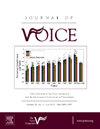自动分析泰米尔语发音人的语音发声二度动感。
IF 2.5
4区 医学
Q1 AUDIOLOGY & SPEECH-LANGUAGE PATHOLOGY
引用次数: 0
摘要
目的:喉肌动率(DDK)可量化喉部和口腔肌肉的协调性,但由于基线证据不足,限制了计算机化 DDK 评估在评估运动言语控制方面的有效性。最后,本研究将就年龄和性别对泰米尔语使用者口腔和喉部 DDK 的影响提供标准数据:研究设计:横断面研究:将年龄在 17-25;11 岁之间的 150 名参与者分为三组--第一组(17-19;11 岁)、第二组(20-22;11 岁)和第三组(23-25;11 岁),男女人数相等。参与者被要求在计算机化语音实验室(CSL)的运动语音档案(MSP)中发出 /pʌ/、/tʌ/、/kʌ/、/pʌtʌkʌ/、/a/& /i/,持续 5 秒钟。选定的分析参数包括平均 DDK 周期(DDKavp)、平均 DDK 速率(DDKavr)、DDK 周期标准差(SD)(DDKsdp)、DDK 周期变异系数(DDKcdp)、DDK 周期扰动(DDKJit)和 DDK 峰值强度变异系数(DDKcvi):年龄对喉DDK、/a/的DDKavr(P = 0.008)和/i/的DDKavr(P = 0.04)以及/a/的DDKcdp(P = 0.01)有影响,年龄在23-25.11岁之间的个体的这些参数的平均值较高,但口腔DDK在不同年龄段没有观察到差异。喉部 DDK、DDKsdp(P = 0.007)和 DDKJit(P = 0.04)的 /i/ 均值对女性有影响。对于口腔 DDK,/kʌ/的 DDKJit (P = 0.006),女性的平均值更高:结论:已为讲泰米尔语的人建立了标准数据。在对 MSP 和 CSL 的语言障碍进行 DDK 评估时,应使用特定年龄的常模。本文章由计算机程序翻译,如有差异,请以英文原文为准。
Automated Analysis of Phonoarticulatory Diadochokinesis in Tamil Speakers
Objectives
Diadochokinetic rate (DDK) quantifies the laryngeal and oral muscle coordination, but there are insufficient baseline evidence exist, that limits the effectiveness of computerized DDK evaluation in assessing motor speech control. In the end, this study will give normative data on age and gender effects on both oral and laryngeal DDK in Tamil speakers.
Study design
Cross sectional Study.
Method
A total of 150 participants in the age range of 17-25;11 years were divided into three groups- Group I (17-19;11 years), Group II (20-22;11 years) and Group III (23-25;11 years) with equal number of male and female. The participants were asked to produce /pʌ/, /tʌ/, /kʌ/, /pʌtʌkʌ/, /a/& /i/ for 5 seconds in Motor Speech Profile (MSP), at Computerized Speech Lab (CSL). The parameters such as Average DDK period (DDKavp), average DDK rate (DDKavr), Standard deviation(SD) of DDK period (DDKsdp), Coefficient of Variation of DDK period (DDKcdp), Perturbations of DDK period (DDKJit) and Coefficient of variation of the DDK peak intensity (DDKcvi) were selected for analysis.
Result
The effect of age was noted for Laryngeal DDK, the DDKavr of /a/ (P = 0.008) and /i/ (P = 0.04) and DDKcdp for /a/ (P = 0.01), the mean values of those parameters are higher for the individuals within the age of 23-25;11 years but no difference was observed across the age for Oral DDK. The effect of gender was noted for Laryngeal DDK, DDKsdp (P = 0.007) and DDKJit (P = 0.04) for /i/, the mean values are higher for females. For Oral DDK, DDKJit (P = 0.006) for /kʌ/ the mean values are higher for females.
Conclusion
The normative data has been established for the Tamil speakers. Age specific normative should be used during the DDK evaluation of speech disorders in MSP, CSL.
求助全文
通过发布文献求助,成功后即可免费获取论文全文。
去求助
来源期刊

Journal of Voice
医学-耳鼻喉科学
CiteScore
4.00
自引率
13.60%
发文量
395
审稿时长
59 days
期刊介绍:
The Journal of Voice is widely regarded as the world''s premiere journal for voice medicine and research. This peer-reviewed publication is listed in Index Medicus and is indexed by the Institute for Scientific Information. The journal contains articles written by experts throughout the world on all topics in voice sciences, voice medicine and surgery, and speech-language pathologists'' management of voice-related problems. The journal includes clinical articles, clinical research, and laboratory research. Members of the Foundation receive the journal as a benefit of membership.
 求助内容:
求助内容: 应助结果提醒方式:
应助结果提醒方式:


